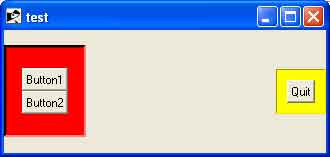
- Ruby Basics
- Ruby - Home
- Ruby - Overview
- Ruby - Environment Setup
- Ruby - Syntax
- Ruby - Classes and Objects
- Ruby - Variables
- Ruby - Operators
- Ruby - Comments
- Ruby - IF...ELSE
- Ruby - Loops
- Ruby - Methods
- Ruby - Blocks
- Ruby - Modules
- Ruby - Strings
- Ruby - Arrays
- Ruby - Hashes
- Ruby - Date & Time
- Ruby - Ranges
- Ruby - Iterators
- Ruby - File I/O
- Ruby - Exceptions
- Ruby Advanced
- Ruby - Object Oriented
- Ruby - Regular Expressions
- Ruby - Database Access
- Ruby - Web Applications
- Ruby - Sending Email
- Ruby - Socket Programming
- Ruby - Ruby/XML, XSLT
- Ruby - Web Services
- Ruby - Tk Guide
- Ruby - Ruby/LDAP Tutorial
- Ruby - Multithreading
- Ruby - Built-in Functions
- Ruby - Predefined Variables
- Ruby - Predefined Constants
- Ruby - Associated Tools
- Ruby Useful Resources
- Ruby - Quick Guide
- Ruby - Useful Resources
- Ruby - Discussion
- Ruby - Ruby on Rails Tutorial
Ruby/TK - Frame Widget
Description
A frame is a widget that displays just as a simple rectangle. Frames are primarily used as a container for other widgets, which are under the control of a geometry manager such as grid.
The only features of a frame are its background color and an optional 3-D border to make the frame appear raised or sunken.
Syntax
Here is a simple syntax to create a Frame Widget −
TkFrame.new {
.....Standard Options....
.....Widget-specific Options....
}
Standard Options
- borderwidth
- highlightbackground
- highlightthickness
- takefocus
- highlightcolor
- relief
- cursor
These options have been described in the previous chapter.
Widget Specific Options
| Sr.No. | Options & Description |
|---|---|
| 1 | background => String This option is the same as the standard background option except that its value may also be specified as an undefined value. In this case, the widget will display no background or border, and no colors will be consumed from its colormap for its background and border. |
| 2 | colormap => String Specifies a colormap to use for the window. The value may be either new, in which case a new colormap is created for the window and its children, or the name of another window (which must be on the same screen ), in which case the new window will use the colormap from the specified window. If the colormap option is not specified, the new window uses the same colormap as its parent. |
| 3 | container => Boolean The value must be a boolean. If true, it means that this window will be used as a container in which some other application will be embedded. The window will support the appropriate window manager protocols for things like geometry requests. The window should not have any children of its own in this application. |
| 4 | height => Integer Specifies the desired height for the window in pixels or points. |
| 5 | width => Integer Specifies the desired width for the window in pixels or points. |
Event Bindings
When a new frame is created, it has no default event bindings: frames are not intended to be interactive.
Examples
require "tk"
f1 = TkFrame.new {
relief 'sunken'
borderwidth 3
background "red"
padx 15
pady 20
pack('side' => 'left')
}
f2 = TkFrame.new {
relief 'groove'
borderwidth 1
background "yellow"
padx 10
pady 10
pack('side' => 'right')
}
TkButton.new(f1) {
text 'Button1'
command {print "push button1!!\n"}
pack('fill' => 'x')
}
TkButton.new(f1) {
text 'Button2'
command {print "push button2!!\n"}
pack('fill' => 'x')
}
TkButton.new(f2) {
text 'Quit'
command 'exit'
pack('fill' => 'x')
}
Tk.mainloop
This will produce the following result −
